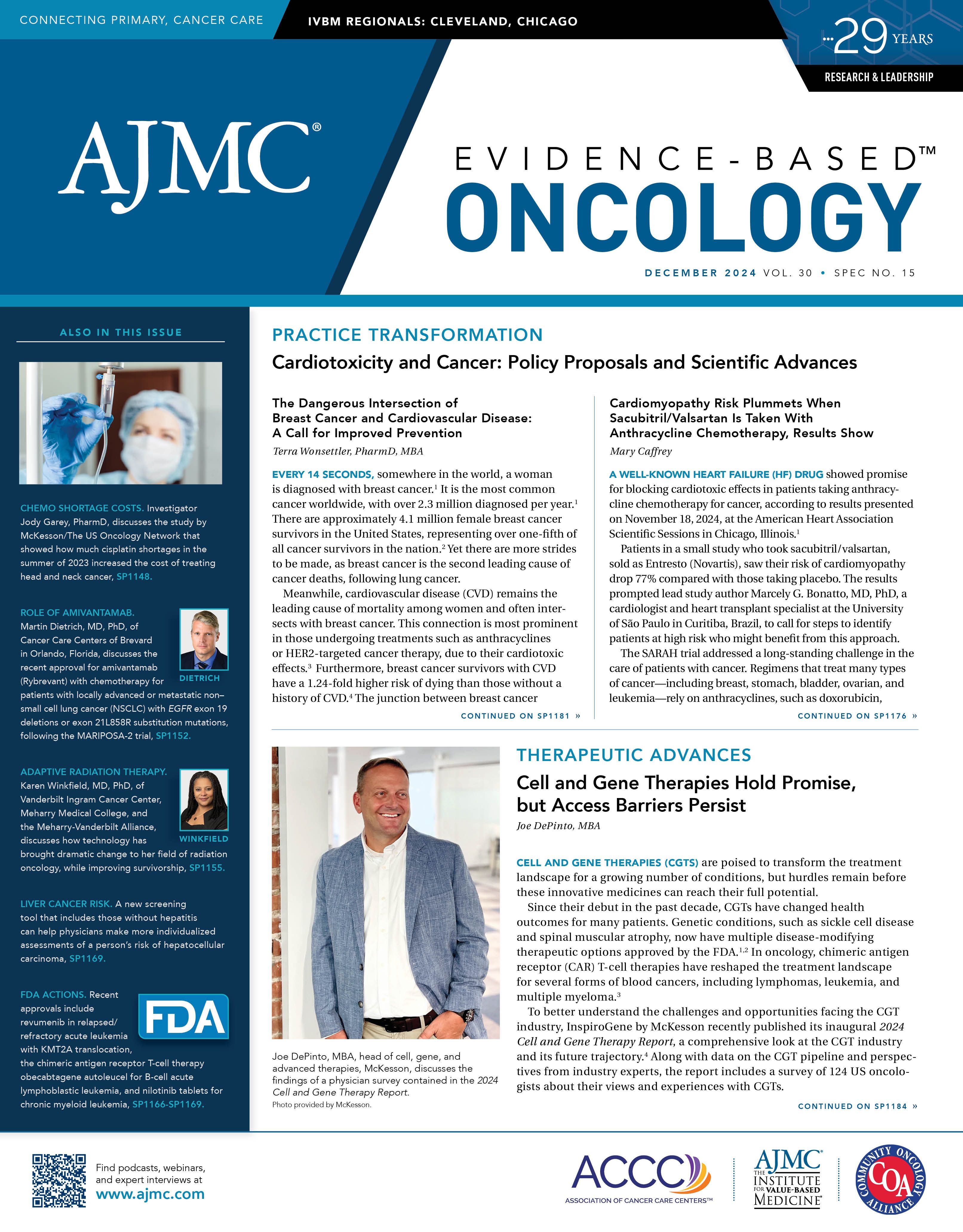- Center on Health Equity & Access
- Clinical
- Health Care Cost
- Health Care Delivery
- Insurance
- Policy
- Technology
- Value-Based Care
Cell and Gene Therapies Hold Promise, but Access Barriers Persist
Cell and gene therapies (CGTs) are poised to transform the treatment landscape for a growing number of conditions, but hurdles remain before these innovative medicines can reach their full potential.
Joe DePinto, MBA | Image credit: McKesson

Since their debut in the past decade, CGTs have changed health outcomes for many patients. Genetic conditions, such as sickle cell disease and spinal muscular atrophy, now have multiple disease-modifying therapeutic options approved by the FDA.1,2 In oncology, chimeric antigen receptor (CAR) T-cell therapies have reshaped the treatment landscape for several forms of blood cancers, including lymphomas, leukemia, and multiple myeloma.3
To better understand the challenges and opportunities facing the CGT industry, InspiroGene by McKesson recently published its inaugural 2024 Cell and Gene Therapy Report, a comprehensive look at the CGT industry and its future trajectory.4 Along with data on the CGT pipeline and perspectives from industry experts, the report includes a survey of 124 US oncologists about their views and experiences with CGTs.
Results from the survey, which was conducted in June and July 2024, showed near universal agreement (99%) that these treatments are “among the most important medical innovations of our time,” with many participants expressing excitement about their curative potential. A strong majority (94%) also said CGTs have the potential to dramatically improve patients’ quality of life.
Surveyed oncologists say they have referred or treated an average of 12 patients with CGTs over the past year. When asked about specific factors driving their decisions to prescribe CGTs, the durability of the therapies’ benefits was among the top responses (88%) along with the potential for improvement in quality of life (87%), potential for improvement in clinical outcomes (85%), and potential for cure (82%).
Barriers Are Significant
Despite the enthusiasm for these therapies, oncologists acknowledge there are also significant barriers to adoption. Nearly two-thirds (64%) of oncologists agreed that CGTs are not easily accessible for patients who meet the labeled indications. Three of 5 physicians (60%) said patients they refer for CGTs often receive other treatments, and when asked why, they mentioned insurance coverage (63%) and out-of-pocket costs (51%) as the most common reasons.
Clinical factors can also be a barrier to CGT adoption. Three of 5 oncologists (61%) agreed that although CGTs show promise for many disease areas, they are still largely unproven. When asked about the factors that influenced their decisions to not prescribe a CGT, some of the top responses included concerns about the safety profile (54%), concerns about the adverse event profile (53%), and uncertainty about the durability of benefits (46%). These responses reflect the newness of this class of therapies and a desire among physicians for more real-world data to demonstrate clinical outcomes over time.
Patient awareness and understanding of CGT options remain low, according to the oncologist survey results. Nearly half of oncologists (47%) said patients are rarely or almost never aware of CGT options for their condition. When patients are informed about CGTs, their most common concerns include the process sounding long and difficult, the newness of the treatment, and the perception that it sounds experimental or risky. In addition, 66% of oncologists said that one of their top reasons for not prescribing CGTs to patients is because the patient “does not want a CGT,” which suggests a lack of knowledge or understanding of the potential benefits.
Access Is Limited in CGT Deserts
Another key barrier is geography. Today, the vast majority of CGT treatment is administered at large academic medical centers (AMCs) in major metropolitan areas, leaving patients in smaller communities and rural areas with limited access to these transformative treatments. This is validated by results from a recent study5 that found the likelihood of receiving a CAR T-cell therapy was reduced by 40% when patients lived 2 to 4 hours from their nearest treatment center.
A strong majority of oncologists surveyed (82%) agree that expanding CGTs into community hospitals is necessary to ensure broader care access for patients; 77% said CGT care should also expand into community clinics. When asked what solutions are needed to support this expansion, top responses included expanding training for clinical staff (70%), establishing industry standards and common processes for CGT ordering and delivery (61%), and expanding administrative resources (55%).
New Payment Models Will Address Costs
Managing the high cost of onetime CGTs in a health care system designed for pay-as-you-go treatments for chronic conditions is another key challenge identified by the report. When oncologists were asked about the factors affecting their decision to not prescribe a CGT, “the inability of the patient to manage both direct and indirect costs” was among the factors that most influenced their prescribing behavior. Patient costs were also cited as a top reason why patients who are referred for a CGT often receive a different therapy.
Despite these concerns, participants in our survey were optimistic that innovative payment models (agreements between pharmaceutical manufacturers and payers to reduce risks and make costs more manageable) will be effective in addressing the challenge. In fact, 86% of surveyed oncologists said innovative payment models will lead to broader adoption of CGTs and 79% agreed they are likely to alleviate disparities in access.
Removing Barriers Requires Collaboration
Overcoming the hurdles highlighted by the results from our survey of oncologists and paving the way to broader adoption are critical to ensuring that these lifesaving therapies reach patients. However, there is no simple fix to these challenges and no single stakeholder group is responsible for the solution. Driving the necessary change will require collaboration and partnership among all the stakeholders in this space, including manufacturers, health systems, providers, payers, and policy makers.
Clinical barriers may be among the easiest barriers to remove. As real-world evidence on the approved CGT products continues to be collected and published by leading researchers in the space, questions about safety and long-term durability are likely to be answered.
Solving the other challenges may prove more difficult. Expanding patient awareness and understanding will require both providers and CGT manufacturers to invest time and resources to ensure patients fully understand their treatment options, including all the potential benefits and drawbacks. Patient education is likely to receive more investment from manufacturers as CGTs move into broader disease categories such as cardiovascular and autoimmune diseases.
Managing the cost of CGTs will require innovation and collaboration across the CGT ecosystem. Several types of innovative payment models are currently being tested in the market, but it is unclear how many are successfully expanding access. More work is needed to develop and test models that deliver long-term financial sustainability for all the key stakeholders, especially for patients.
Expanding CGT care into the community will necessitate collaboration between AMCs and community sites of care. A few of the leading AMCs with established CGT programs are already sharing their operational best practices and training resources with community hospitals, essentially providing a road map that enables community sites to quickly set up their own CGT programs. These partnerships allow AMCs and community hospitals and clinics to work together to determine the best site of care for patients, but more of these relationships will be needed in the future to meet the growing demand for advanced care.
Looking Forward
Despite the current challenges, most oncologists (53%) surveyed believe CGTs will become widely accessible within the next decade. If the past decade is any guide, the next 10 years will continue to see more innovative therapies reach patients in need. The FDA has approved more than 30 CGTs to date,6 and thousands more are in development.7
To ensure patients in need can access these medicines, the industry needs to expand where they are administered, collect more long-term data on durability and safety, consider new ways of paying for them, and continue educating patients about their potential. By taking these actions, the advancements of today can be transformed into the groundbreaking care of tomorrow.
Author Information
Joe DePinto, MBA, is head of cell, gene, and advanced therapies at McKesson.
References
1. FDA approves first gene therapies to treat patients with sickle cell disease. News release. FDA. December 8, 2023. Accessed October 15, 2024. https://www.fda.gov/news-events/press-announcements/fda-approves-first-gene-therapies-treat-patients-sickle-cell-disease
2. Flinn R. SMA treatments save lives and money, but economic barriers hinder access. Managed Healthcare Executive®. July 19, 2024. Accessed October 15, 2024. https://www.managedhealthcareexecutive.com/view/sma-treatments-save-lives-and-money-but-economic-barriers-hinder-access
3. Cappell KM, Kochenderfer JN. Long-term outcomes following CAR T cell therapy: what we know so far. Nat Rev Clin Oncol. 2023;20:359-371. doi:10.1038/s41571-023-00754-1
4. 2024 Cell and Gene Therapy Report. InspiroGene. Accessed November 10, 2024. https://inspirogene.com/2024cgtreport/
5. Ahmed N, Karmali R, Nath R, et al. Chimeric antigen receptor T-cell access in patients with relapsed/refractory large B-cell lymphoma: association of access with social determinants of health and travel time to treatment centers. Transplant Cell Ther. 2024;30(4):190-198. doi:10.1016/j.jtct.2024.04.017
6. Approved cellular and gene therapy products. FDA. August 2, 2024. Accessed October 16, 2024. https://www.fda.gov/vaccines-blood-biologics/cellular-gene-therapy-products/approved-cellular-and-gene-therapy-products
7. Gene, Cell, & RNA Therapy Landscape Report: Q2 2024 Quarterly Data Report. American Society of Gene & Cell Therapy. 2024. Accessed October 16, 2024. https://www.asgct.org/global/documents/asgct-citeline-q2-2024-report.aspx

Oncology Onward: A Conversation With Dr Debra Patt of Texas Oncology
August 1st 2023Debra Patt, MD, PhD, MBA, joins hosts Emeline Aviki, MD, MBA, and Stephen Schleicher, MD, MBA, for episode 2 of our newest podcast, "Oncology Onward: Conversations With Innovators and Changemakers in Cancer Care."
Listen
Community Oncology Reacts to Trump's Drug Pricing Executive Order
May 2nd 2025An executive order signed on Tuesday, March 15, necessitated a change in plans for this panel discussion from the 2025 Community Oncology Conference, with the assembled experts, moderated by Ted Okon, MBA, executive director of the Community Oncology Alliance, speaking to how the order would reverberate across the community oncology space.
Read More
